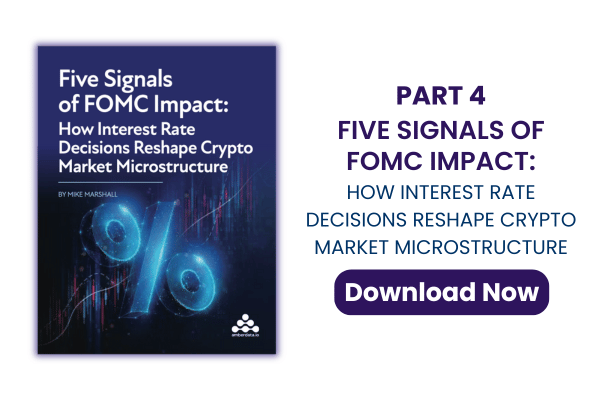
Deribit's "Crypto Options Unplugged" with the brilliant minds of David Brickell and Imran Lakha as hosts! Uncover deep insights, strategies, and the latest in crypto options. Don't miss this podcast episode featuring special guest Greg Magadini, Director of Derivatives at Amberdata. Stay tuned for more!
Crypto Market Update: Uptober & Seasonal Trends
The October edition of Crypto Options Unplugged delivered a wide-ranging discussion on crypto’s market structure, seasonal trends, and macroeconomic backdrop. Hosted by Imran Lakha (Options Insight) with David Brickell (FRNT Financial) and special guest Greg Magadini, Director of Derivatives at Amberdata, the conversation highlighted diverging narratives across Bitcoin, Ethereum, Solana, equities, and gold set against the backdrop of shifting global debt dynamics and collapsing crypto volatility.
Market Performance: Uptober Momentum
The quarter opened with a sharp but short-lived dip across digital assets, quickly followed by a strong recovery. Sentiment remains muted despite resilient price action, with Bitcoin consolidating near the $108K zone and Ethereum holding firm above $3,800 after its explosive summer rally. The divergence in sentiment versus performance is notable: while equities continue to push record highs and gold rallies aggressively, crypto appears capped by supply overhang and cautious institutional flows.
Nevertheless, Lakha and Brickell stressed that Q4 seasonality has historically been supportive for risk assets. The absence of the typical September weakness further reinforces a bullish backdrop heading into year-end. Ethereum, in particular, is seen as having “unfinished business” at the $5,000 level, supported by strong structural narratives around tokenization, stablecoins, and blockchain adoption.
Structural Themes in Volatility
Guest Greg Magadini, Head of Derivatives at Amberdata, highlighted a defining trend: realized volatility in crypto has collapsed to multi-year lows, with Bitcoin trading on a 20-handle realized vol—comparable to major equities. This structural decline reflects the growing institutionalization of the asset class.
Yet Magadini argued that cyclical spikes in volatility are far from over. “Tectonic plates are shifting,” he noted, pointing to the global debt supercycle and fiat sustainability concerns as potential catalysts for volatility shocks that could favor Bitcoin as “digital gold.”
The volatility landscape also shows important differences between assets. Ethereum continues to carry a significant volatility premium to Bitcoin, reflecting both its risk-on positioning and higher structural uncertainty. Meanwhile, Solana’s implied vol has compressed sharply—making end-of-year call options appear relatively cheap compared to its historical realized volatility.
Macro Backdrop: Gold, Debt, and Fiat Currency Pressures
A dominant theme throughout the discussion was the interplay between gold, Bitcoin, and the global debt environment. Gold has significantly outperformed Bitcoin in 2025, reflecting both momentum trading and genuine institutional demand as the traditional 60/40 portfolio model breaks down. With central banks diversifying reserves and asset managers reallocating toward gold over bonds, demand appears secular rather than cyclical.
Magadini drew parallels between gold’s $25 trillion market cap and Bitcoin’s $2 trillion valuation, arguing that Bitcoin’s portability and bearer-asset qualities make it a superior long-term alternative. However, near-term decoupling is evident: gold and silver continue to rally while Bitcoin consolidates, suggesting that institutional holders still treat Bitcoin as a risk-on asset rather than a safe haven.
Japan’s financial position was discussed as a preview of broader Western challenges. With debt-to-GDP exceeding 250% and demographic decline exacerbating fiscal pressures, Japan is seen as the furthest along the path of monetary debasement. Rising yields in the Japanese government bond (JGB) market illustrate the difficulty of refinancing massive debt loads. This “Japanification” dynamic is likely to extend to the U.S. and Europe, reinforcing the case for alternative stores of value like gold and Bitcoin.
Ethereum: Tech Play and Institutional Rails
Ethereum’s resurgence was a focal point. After years of underperformance, ETH surged from $2,800 to near $4,800 over the summer, driven in part by digital asset treasury adoption and tokenization narratives. Both Lakha and Magadini expect ETH to retest and potentially break new all-time highs.
The long-term thesis for Ethereum is tied to its role as the “world computer” and foundational layer for Web3. Institutions continue to build rails for tokenized assets, stablecoins, and DeFi on Ethereum rather than competing blockchains. Magadini likened ETH to the iPhone, with decentralized applications serving as its ecosystem of “apps.” This structural adoption, combined with staking yields and relative underownership, underpins the bullish case.
Solana: Emerging Opportunities
Solana (SOL) was another point of optimism. Once viewed as a niche competitor, Solana has gained traction through memecoin trading, stablecoin issuance, and EVM-compatible development. Its U.S. regulatory positioning and ecosystem growth make it a legitimate alternative alongside ETH.
From a derivatives standpoint, Solana’s implied volatility around 70 for December expiries appears cheap relative to ETH, suggesting attractive opportunities for call option exposure into year-end. A $1,000 SOL scenario was described as “business as usual,” underscoring its potential upside in a bullish Q4.
Options Market Dynamics
The team also examined the implications of Deribit’s recent $20 billion Bitcoin options expiry. While large in notional terms, the open interest equates to just ~1% of Bitcoin’s $2 trillion market cap. Compared to equities like Tesla—where options OI represents ~15% of market cap—crypto options markets remain too small to exert material influence on spot prices. Instead, expiries impact funding rates in perpetual futures, creating relative value opportunities rather than direct price shifts.
Amberdata Intelligence Launch
Magadini concluded with a product update: Amberdata is rolling out Amberdata Intelligence, an AI-powered platform unifying on-chain, spot, futures, and derivatives data. Users will be able to combine datasets on demand, generate custom visualizations, and organize insights into “liveboards.” The platform aims to help institutions and traders move beyond static dashboards toward dynamic, AI-assisted market intelligence.
Outlook: Q4 and Beyond
As Q4 begins, optimism remains despite subdued sentiment. The key takeaways are:
-
Bitcoin: Consolidating, may face further correction toward 100K, but structurally supported by macro debasement themes.
-
Ethereum: Strong chart setup, unfinished business near $5,000, long-term adoption story intact.
-
Solana: Undervalued vol, strong ecosystem growth, potential for sharp upside.
-
Gold: Secular institutional demand, outperforming crypto near-term but reinforcing digital gold narrative longer-term.
-
Macro: Japanification of global debt, fiat sustainability concerns, and Fed/BOJ policy responses remain critical drivers.
Overall, the discussion underscored that while short-term price action reflects supply/demand imbalances and cautious positioning, the structural forces of debt, fiat debasement, and institutional adoption strongly favor crypto’s long-term growth trajectory. Uptober may be just the beginning of a powerful Q4 rally across digital assets.
Amberdata
Amberdata is the leading provider of global financial infrastructure for digital assets. Our institutional-grade solutions deliver data, analytics and comprehensive tools and insights that empower financial institutions to research, trade, and manage risk and compliance in digital assets. Amberdata serves as a...
